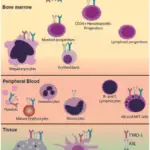Defects in lymphocyte activation and function are failure to trigger antigen-specific receptors on the cell surface of lymphocytes. The failure to proliferation and differentiation into specialized cells results in defects. Examples of defects in lymphocyte activation include X-linked hyper-IgM syndrome, defective class II MHC expression, and T cell receptor defects.
What are Defects in Lymphocyte Activation and Function?

Proposed molecular mechanisms of cytotoxic granule exocytosis illustrated with genetic defects that cause primary HLH. CTL activation by class I MHC-associated antigen of the target cell leads to MTOC polarization and transport of cytotoxic granules. Cytotoxic proteins including granzyme, perforin, and FasL are sorted from the TGN by the M6PR. AP3B1 and LYST are involved in sorting and transport of cytotoxic granules. Using the motor protein dynein-dynactin complex, the granules move along the microtubules toward the MTOC that is polarizing toward the CTL-target cell contact site. The granules then switch from microtubules to the actin filament using another motor protein myosin IIA navigating toward the plasma membrane at the immune synapse, where docking takes place through the interaction of Rab27a and Munc13-4, as well as through the recognition of STX11 and Munc18-2 (STXBP2). After docking, the granules are primed by Munc13-4, which probably triggers the conformational change of STX11 from a closed to an open form by removal of STXBP2. A SNARE complex then forms between a v-SNARE (VAMP) on one side and the t-SNAREs (STX11 and SNAP23) on the other side. Formation of this four-helix SNARE complex bundles leads to membrane fusion and release of the granule contents into the immune synapse. Granzymes enter into the target cell through the pores formed by perforins and provoke apoptosis through activation of caspases. FasL binds to Fas on the target cell surface and initiate apoptosis as well. Various types of primary HLH caused by genetic defects in granule-mediated cytotoxicity are highlighted.Abbreviations: HLH, hemophagocytic lymphohistiocytosis; CTL, cytotoxic T lymphocyte; MTOC, microtubule organizing center; M6PR, mannose-6-phosphate receptor; AP3B1, AP-3 complex subunit beta-1; LYST, lysosomal trafficking regulator; FasL, Fas ligand; TGN, trans-Golgi network; STX11, syntaxin 11; STXBP2, syntaxin binding protein 2; SNARE, soluble N-ethylmaleimide-sensitive factor attachment protein receptor; v-SNARE, vesicle membrane SNARE; VAMP, vesicle-associated membrane protein; t-SNARE, target membrane SNARE; SNAP23, synaptosomal-associated protein of 23 kDa; CHS, Chédiak-Higashi syndrome; HPS2, Hermansky-Pudlak syndrome type 2; GS2, Griscelli syndrome type 2; FHL, familial HLH. Hematopoietic cell transplantation for hemophagocytic lymphohistiocytosis: recent advances and controversies. Seo JJ - Blood research (2015). Not Altered. CC.


